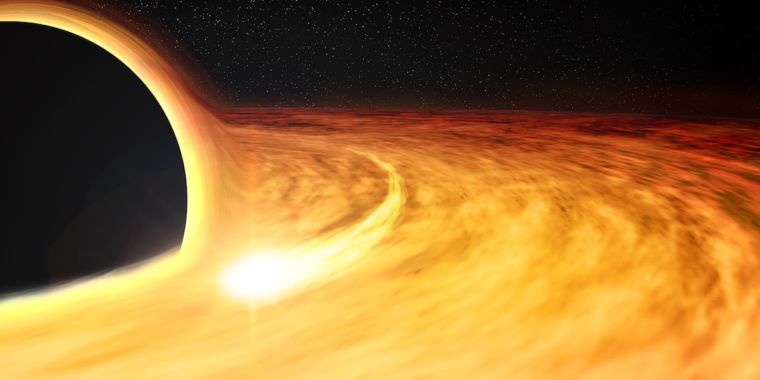

/ Artist’s conception of a blob of hot matter orbiting close to surface of a black hole. At this distance, its orbit is influenced by the black hole’s spin.
While black holes themselves swallow any light beyond their event horizon, the area outside the event horizon tends to emit lots of light. That’s because the material falling in toward the black hole is extremely energetic as it sheds angular momentum and crashes in to other material in orbit around the black hole. So, while we can’t image a black hole directly, we can infer some things about its properties using light from the environment it creates.
This week saw the publication of two papers that edge in to the area close to the event horizon, imaging events in an area that includes some of the closest stable orbits to the black hole. And, in doing so, one of them finds that a supermassive black hole is spinning so fast that a location on its surface would move at roughly half the speed of light.
Echoes of a corona
Both of these papers take advantage of periodic outbursts that happen when the black hole starts to feed on new material. That material heads into the hole via a flat structure centered on the black hole called an accretion disk. Its arrival heats the disk up, causes the black hole to brighten, and causes changes in the local environment. The questions that these two papers focus on is what these changes can tell us about the black hole and the environment nearby.
One of the studies focuses on a stellar-mass black hole, or one that’s typically less than 10 times the mass of the Sun. In response to some infalling matter, one of these black holes created a transient event called MAXI J1820+070, which gets part of its name from the International Space Station’s Monitor of All-sky X-ray Image instrument, or MAXI. The event’s discovery was then followed up by observations using a different piece of ISS-based hardware, the Neutron star Interior Composition Explorer (or NICER). NICER has the ability to perform very rapid measurements of the X-rays coming from astronomical sources, making it great for tracking short-term changes in an object.
In this case, NICER was used to perform what’s called “reverberation analysis.” This technique relies on the fact that, in addition to the accretion disk, black holes have a corona, which is a blob of energetic material above and below the plane of the disk. This corona will produce X-rays of its own, which instruments can detect. But those X-rays also run into the accretion disk, and some of them get reflected back toward us. These light reverberations can tell us something about the details of the accretion disk.
Mystery solved
In this case, they solved a bit of a mystery. In the supermassive black holes at the center of galaxies, imaging had suggested that the accretion disk extended in to the closest stable orbit possible around the black hole. But measurements of stellar-mass black holes indicated that the edge of the accretion disk was much further out. Since there were no obvious reasons why the physics should change with size, these measurements were a little confusing.
The new analysis shows that there are both variable features and constants to the X-ray emissions of MAXI J1820+070. The constant features suggested that the accretion disk, which provides the echoes, wasn’t changing its location at all; instead, the variable features suggest that, as the black hole feeds, its corona becomes more compact, thereby shifting the source of the X-rays. Details of the constant signal suggest that the accretion disk is much closer to the black hole, bringing measurements in line with what we’ve learned from the supermassive versions.
A star is killed
Over in supermassive land, we have ASASSN-14li, discovered by the All-Sky Automated Survey for SuperNovae. This outburst had the features that are associated with what’s called a “tidal disruption event,” in which the black hole’s gravity tears apart a star that happened to wander too close. Follow-up observations, however, showed there was a peculiar structure in the signal: every 130 seconds, it brightened briefly.
While the signal didn’t stand out from the background of the star’s destruction, it was present in data from three different instruments, suggesting there was something happening periodically. The simplest explanation is that part of the star wound up in orbit around the black hole. The frequency of these orbits would depend on the mass and spin of the black hole, as well as the distance between the black hole and the object orbiting it. A black hole’s spin is difficult to measure any other way, so the researchers ran multiple simulations trying out different configurations for the black hole system.
The mass of the black hole was estimated based on the size of the galaxy it in habits. Spin and orbital distance have a simple relationship: the closer something is to a black hole, the slower the black hole can rotate to have the object orbit at the same speed. So, by calculating the closest possible orbit, they were able to provide a minimum value on the spin.
The calculations suggested that the black hole is rotating at least at a speed where a point on its surface would be moving at about half the speed of light. (For context, a supermassive black hole may be big enough that its radius may be about the same as the orbital radius of Saturn or Neptune.) If the material is orbiting any farther out, then the black hole is rotating even faster.
While we still aren’t able to image black holes directly, the two papers show that there are enough events happening at black holes somewhere in the Universe to give us a lot of data on their behavior. And, through this, we’re now able to draw some inferences about the properties of the black holes themselves, as well as the material that’s waiting to join them. We’re also starting to get some information from gravitational wave detections, which provide information about the mass and spins of the black holes that collide. Combined, this data is making sure that “black” doesn’t mean terra incognita.
Nature, 2019. DOI: 10.1038/s41586-018-0803-x
Science, 2019. DOI: 10.1126/science.aar7480 (About DOIs).









